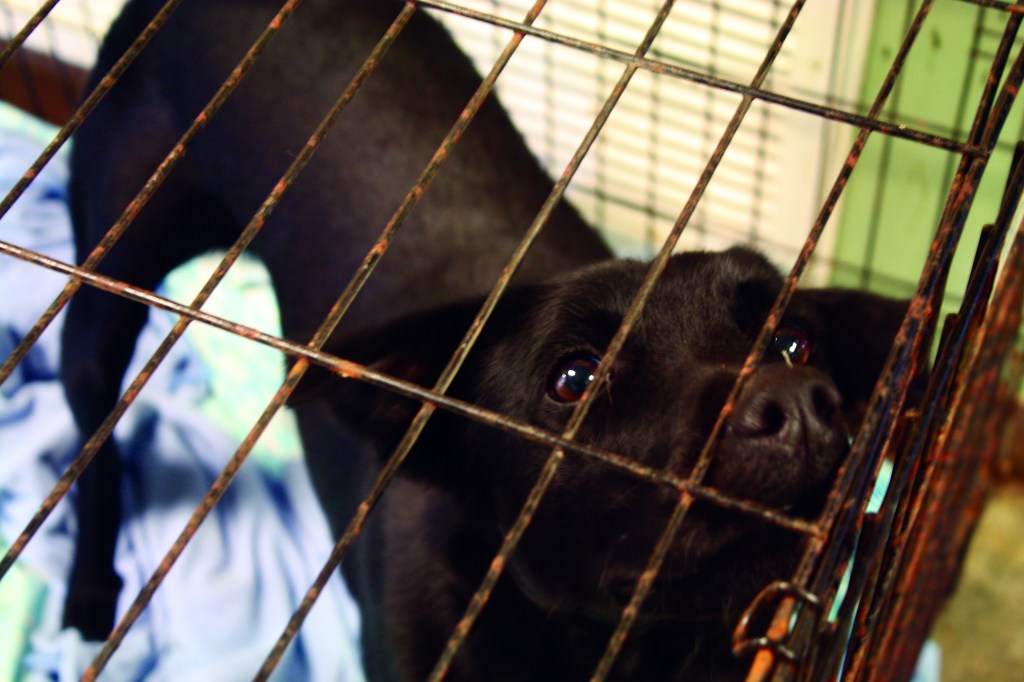Combating negligent breeding and a failure in care
Published 11:45 am Wednesday, March 29, 2023

- Young dog relaxing in housing, waiting on possible adopters.
A little girl’s excited squeals reach a crescendo at the sight of the squirming, 10-pound, 4-month-old bundle of joy. The dog, a poodle rescued with his littermates some weeks back, isn’t fazed. It’s fluffy, apricot tail a blur, the pup romps along on the damp, grassy yard of poodle breeder Tabatha Waters.
The family of the newly-five-year-old, her mom and her father, seemed just as eager to meet the pups. Who wouldn’t be? But this was different. They were seeking a dog with service potential for the girl’s father, a wheelchair user.
After 30 joyous minutes of gentle puppy kisses and careful examination by the parents, the family took home Pibbles. Calmer (and bigger) of the two young poodles, Pibbles, quickly connected with the family. This story has a happy ending, but not so many dogs are as lucky as Pibbles.
According to the Humane Society of the United States, there are roughly 10,000 puppy mills in the United States. Only 3,000 of those are USDA approved. Despite being one of the few states which set a limit on the number of puppies allowed for breeding purposes, Louisiana has no listed humane requirements for breeding, only licensing requirements.
“As long as you have shelter and food and water, it don’t matter if you on a 1-foot lead outside; on some pallets you know, covered by a tarp,” said Brooke Lustman, executive shelter director at Angel Paws Adoption Center. “And that’s their money makers, unfortunately. The animals’ quality of life’s nothing, but they’re sittin’ there paying the bills. It doesn’t make sense!”
The issue goes beyond puppy mills, however, as mixed breeding practices rise in popularity. The concept of “doodling,” or mixing poodles with another breed, rose in popularity over the past few years. This practice, although harmless on its own, when combined with negligent breeding practices, creates a cycle of abuse.
Traditional, full-blooded dog breeds see thousands of dollars of research from national breed clubs invested into researching the breed. This research develops the breed standard, or the ideal example of the dog. This doesn’t just include the positives, as it also identifies the health risks, temperament issues and care requirements native to the breed.
The same cannot be said for mixed dogs. Mixed breeds can be a genetic grab-bag, pulling various traits from each parent breed. This results in breeders who don’t have a full picture of the health risks, care responsibilities and temperament of the puppies they sell. According to Hana Perkins, a dog trainer centered in Lafayette, these breeders don’t adequately prepare new owners for what to expect with their dogs.
“Goldendoodles whose parents aren’t the greatest temperament end up being unstable messes and just a genetic disaster. Poodles have ear infections and skin issues. Golden Retrievers, they are known for having cancer later,” Perkins said.
People buy doodles for their image instead of for their lifestyle and needs, according to Perkins. While both golden retrievers and Poodles are easy-going dogs, they are also high-energy and require exercise and attention.
“I have a Doberman. I would not have her if I didn’t have this job because I know what her needs are. She needs exercise, she needs constant training. She needs something to do all of the time. If I didn’t have this job, she would be left at home eight hours out of the day and you know, get walks whenever I could come home. She can fit into my lifestyle,” Perkins said.
Unknowing doodle breeders often assume the dogs don’t require brushing and are always hypo-allergenic, especially with the most popular of the breed, golden doodles. While poodles have tight curly hair which shed similarly to humans, losing only a few strands at a time, golden retrievers have top and bottom coats of long, fluffy fur that sheds at a rapid rate.
Goldendoodles may develop both coats with the curls holding onto shed hair. If these dogs aren’t brushed often, the bottom coat will continually shed into the topcoat, where the tight curls grab onto them like Velcro, and severe matting occurs.
According to Jackie Benitez, a groomer currently employed at PetSmart, if left unchecked, this matting can cause irritation, hematomas, or swelling blood clots, and bleeding when finally brushed out.
“To us, it’s abuse. You aren’t taking care of the dog at home, and it’s obvious,” Benitez said.
To avoid bleeding, these dogs require specialized equipment to shave them. This process takes much longer than a standard groom and comes with an additional cost. Mixed with the persistent popularity of the “breed,”, groomers are being forced to turn away doodles.
“They want to call us lazy for not brushing out matting and not wanting to hurt the animal. We put his needs above your vanity and that makes me lazy? Ultimately, it should be humanity over vanity,” Benitez said.
Lustman worked with Angel Paws Adoption Center for eight years, but she saw the highest number of animals in the shelter over the past three. Inevitably, costs and responsibilities build and, according to Lustman, pet owners can’t handle the pressure and abandon or relinquish their former companions.
“People have no clue what they are getting into when they get these dogs. They don’t realize the grooming it takes, the medical care. Ya’ know, people judge animals based on looks, but once you get involved with the care and the cost, it becomes a problem. That’s when dogs end up here,” Lustman concluded.





